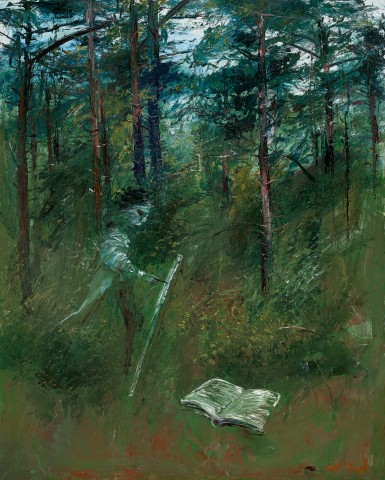SUFFOLK LANDSCAPE, FIGURE AND BOOK, 1973
ARTHUR BOYD
oil on canvas
151.5 x 121.5 cm
signed lower right: Arthur Boyd
Fischer Fine Art, London
Tolarno Galleries, Melbourne
The National Australia Bank Art Collection, acquired from the above in 1975 (label attached verso)
Arthur Boyd: Recent Paintings, Fischer Fine Art, London, May – June 1973, cat. 25 (illus. in exhibition catalogue, p. 13)
The Seventies: Australian Paintings and Tapestries from the Collection of National Australia Bank, National Gallery of Victoria, Melbourne, 15 October – 28 November 1982
Ford, B. (ed.), The Cambridge Cultural History of Britain, Vol. 9: Modern Britain, Cambridge University Press, London, 1992, p.110
Lindsay, R., The Seventies: Australian Paintings and Tapestries from the Collection of National Australia Bank, The National Bank of Australasia, Melbourne, 1982, pl. 14, p. 27 (illus.)
Suffolk landscape, figure and book, 1973 – 74, oil on canvas, 315.0 x 434.2 cm, in the collection of the National Gallery of Australia, Canberra
Suffolk landscape, figure and book, 1973, belongs to an extraordinary series painted by Arthur Boyd after he returned from his first visit to Australia in more than a decade. Having been awarded a Creative Arts Fellowship at the Australian National University in Canberra, he arrived to find himself dazzled again by the bright Australian light during the blazing summer of 1971 – 1972, leading him to question his connection to his homeland as well as his true intentions as an artist. By this time, he had been living in England since 1959, and had studios in London and in Suffolk, where ‘his studio window opened on to a copse of spruce, larch and other trees’1; it was within this quintessential English setting that he began his personal interrogation.
Boyd remains one of this country’s leading landscape artists and this is largely because of his individualistic identification with this motif, whether during his teenage years painting alongside his grandfather on the bucolic Mornington peninsula, or conversely, in the tangled primeval forests he depicted from the late 1940s. Boyd enjoyed great success in London following a huge retrospective of his work mounted by the Whitechapel Gallery in in 1962; and by 1973, when Suffolk landscape, figure and book was painted, a new Boyd exhibition was a major event on the British art calendar. For his show that year, Fischer Fine Art responded to the occasion with a richly illustrated catalogue, and of particular note is the chronological format of the publication, which allows the reader to follow the artist’s trajectory of thought and divergent inspirations.
The sequence starts gently with Suffolk landscape with gate, 1973, which mirrors the stillness of the artist’s Wimmera paintings of the 1950s, whilst the following works feature a nude model (Boyd’s wife Yvonne) sitting quietly by a stream in the forest next to the studio. At first, she is reading but suddenly, the book is discarded and she confronts the viewer with a candid stare in a pose recalling Boyd’s previous paintings of Susannah and the Elders. In the next work, Suffolk pine forest and book, 1973, the nude has departed the scene but her discarded book ‘lies open, almost readable to the viewer emphasising the strong influence of literary tradition and inspiration within English art.’2 Disquiet also enters the frame through the impasto treatment of the sky, and indeed, a storm appears to be brewing, indicative of the artist’s mind as Boyd begins to consider his role and antagonistic fate as an artist. In the work on offer here, Suffolk landscape, figure and book, a distinct spikiness now infests the forest, with broken branches and pine needles scattered over the scene like thorns, while in the foreground stands the fugitive figure of the artist himself as he attempts to realise his vision, no doubt aware of the turbulent sky, cloud riven and intense. This is the last moment of relative peace in the sequence before Boyd’s creative demons arrive, a process charted over successive paintings where the storm has passed, but left in its wake a brutal transformation in the now-helpless artist – adrift in the wild, with a muzzled dog mounted on his crouching back.
1 Hoff, U., The Art of Arthur Boyd, Andre Deutsch, London, 1986, p.65
2 Lindsay, R., The Seventies: Australian paintings and tapestries from the collection of The National Australia Bank Art Collection, National Bank of Australasia, Melbourne, 1982, p. 27
ANDREW GAYNOR
